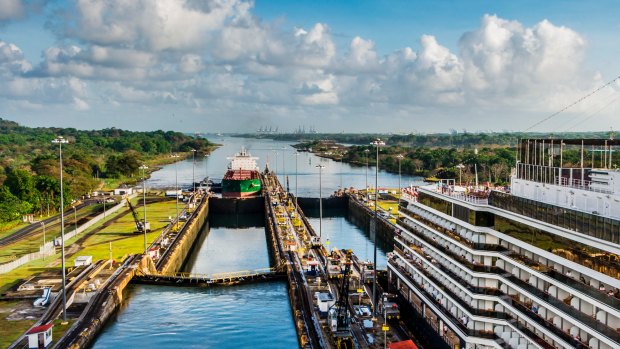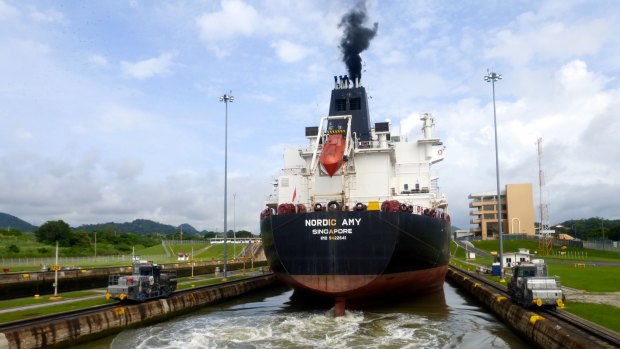This was published 6 years ago
The Panama Canal: A cruise along one of the world's engineering wonders
By Alison Stewart

The 80-kilometre artificial waterway is a wonder of the modern world.Credit: SHUTTERSTOCK
The question is – should one wave at a dictator? It's one of many questions posed on our partial transit of one of the engineering wonders of the modern world – the Panama Canal.
The canal is testament to human ingenuity. The vision to carve an 80-kilometre artificial waterway through Central America to connect Atlantic and the Pacific was a masterful engineering feat, tribute to the breadth of human imagination and persistence.
The canal rises and falls 26 metres from the Pacific to the Atlantic, navigating a man-made, 13.5-kilometre Culebra Cut in the continental divide. Locks provide three steps up and three down. Despite sea levels being the same, tidal and geographic variations mean that, with no locks, the canal would be a series of raging rapids. But the determination to conquer nature is also evidence of ruthlessness, greed and folly given that 27,000 people died in its construction, 50,000 people were displaced, entire valleys, mountains, rainforests and communities were destroyed and species became extinct.

A tanker passing through Miraflores lock, guided by electronic "mules".Credit: Alison Stewart
The US completed the canal in 1914 after the French abandoned it due to the high worker mortality rate and engineering difficulties.
We've come to this tropical isthmus country of 4 million people, that sits at about nine degrees above the Equator between Colombia and Costa Rica, as part of a Captain's Choice private jet three-week tour of South America.
Our journey takes in Argentina, Brazil, Cuba, Panama, Ecuador, Peru and Chile's Easter Island. Panama has a complicated history – since the 1500s, this strategic country has endured piracy, Spanish conquistadors, Inca gold and silver fortune-hunting, slavery, American invasion, exploitation, drug trafficking, dictatorships, torture and assassinations.
On December 31, 1999, the US turned over control of the Panama Canal, which is a significant contributor to Panama's fortunes. Seven per cent of the world's shipping uses this shortcut to avoid the 22-day trip around South America's hazardous Cape Horn.
It's a 6am departure from our central Panama City hotel as Panama transits are strictly regulated and paid for beforehand – $US4000 for our 37-metre Pacific Queen, which Captain's Choice has exclusively chartered – if a ship misses its slot, tough. About 40 vessels pass through daily for the eight to 10-hour transit.
A neopanamax container ship paid $US829,468 for a 2016 transit. Panamax and neopanamax refer to the size limits of ships travelling through the canal. American adventurer Richard Halliburton paid just 36 cents to swim the canal in 1928. Submarines are also allowed.
We board the Pacific Queen at Flamenco marina as the sun rises over Panama Bay, reflecting off the muscular Trump Tower on the Panama City waterfront. Our transit number is 21 and time is of the essence. Ships travel from Pacific to Atlantic between 6am and 3.15pm and the other way from 3.45pm to 11pm. North and south traffic is permitted at other times.
We pass under the Bridge of the Americas, a Sydney Harbour Bridge-lookalike that spans the canal's Pacific entrance connecting North and South America, and our first lock, the Miraflores, with its two-step, 16.5-metre rise, looms ahead.
We are partnered with a tanker and a catamaran bearing a family including a free-range toddler in pink floaties. Bells sound as the tanker enters the lock and is attached to the electronic "mules" that guide ships between dripping walls you can practically touch. We're next, then the catamaran is linked to us before a pilot boards.
The massive gates close and water pours into the 296-metre-long, 33-metre-wide chamber to lift us in two, eight-metre stages from sea level. It takes 98 million litres of water pumped in during eight minutes to raise us one step, our guide tells us.
A third, wider lane of locks was completed in 2016 for neopanamax ships – colossal beasts of the sea that seem to be travelling on land alongside us.
Canal stickybeaks line the Miraflores Visitors Centre to watch the lock transit. Some of our group visited the day before for an in-depth lesson in canal operations.
After the Miraflores lock comes the Pedro Miguel lock with its nine-metre rise, then we sail the engineering miracle of the "big ditch" – the Culebra Cut (formerly the Galliard Cut), the artificial valley that slices through the continental divide. It's 12.6 kilometres from the Pedro Miguel lock to the Chagres River arm of Lake Gatun, with the water level at 26 metres above sea level.
We pass close to the Renacer Prison, which has a waterfront position on the canal at Gambon. At the time of our visit, the 83-year-old brutal tyrant, the machete-waving Manuel Noriega, was ensconced in an airconditioned, one-bedroom apartment here, though he was released on medical grounds a few months later and died in May last year.
Noriega brutally ruled from 1983 to 1989, enriching himself through drug trafficking and money laundering and killing opponents. It's possible he is looking up from his computer, or television, to observe our passage.
We pass under the canal's second permanent crossing, the six-lane Centennial Bridge. It opened in 2004 to supplement the overcrowded Bridge of the Americas. Southbound vessels line up for their crack at the canal as we disembark.
It's a beautiful trip back to Panama City through the Panama Canal rainforest, home to jaguars, wild cats, the famous Panamanian butterflies, American crocodiles and spectacled caymans, the majestic harpy eagle, sloths, spider monkeys, tamarins, capuchins, blue-footed boobys and many more.
That night, we visit Panama City's World Heritage-listed Casco Viejo or old city with its neoclassical buildings, convents and pretty squares for a spectacular dinner at the tiny Donde Jose.
This restaurant tells Panama's story through exquisite acidic, smoky and spicy dishes. Panamanian cuisine uses all parts of the animal so Donde Jose's 17 tiny courses can include tongue, heart, liver and feet, but very delicious feet they are.
Finally, to answer the initial question – just as you would never smile at a crocodile, neither should you wave at a murderous knave.
Alison Stewart was a guest of Captain's Choice.
TRIP NOTES
MORE
FLY AND TOUR
Captain's Choice Discovery of South America is a 22-day journey by private jet from Sydney to Buenos Aires, Iguassu Falls, Rio de Janeiro, Havana, Machu Picchu, Panama City, the Galapagos Islands, Cuzco and Easter Island. Departs Sydney on August 23, 2018, and is priced from $89,500 a person twin share. See captainschoice.com.au or call 1800 650 738.
EAT
Donde Jose, Casco Viejo, Panama. See dondejose.com
Sign up for the Traveller Deals newsletter
Get exclusive travel deals delivered straight to your inbox. Sign up now.